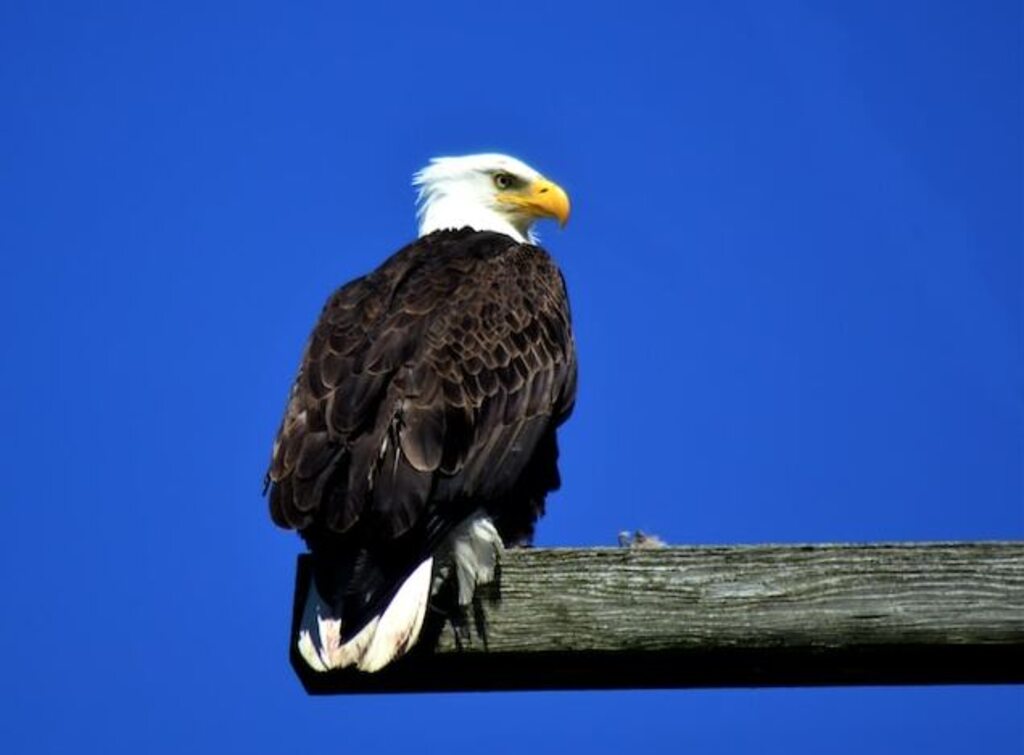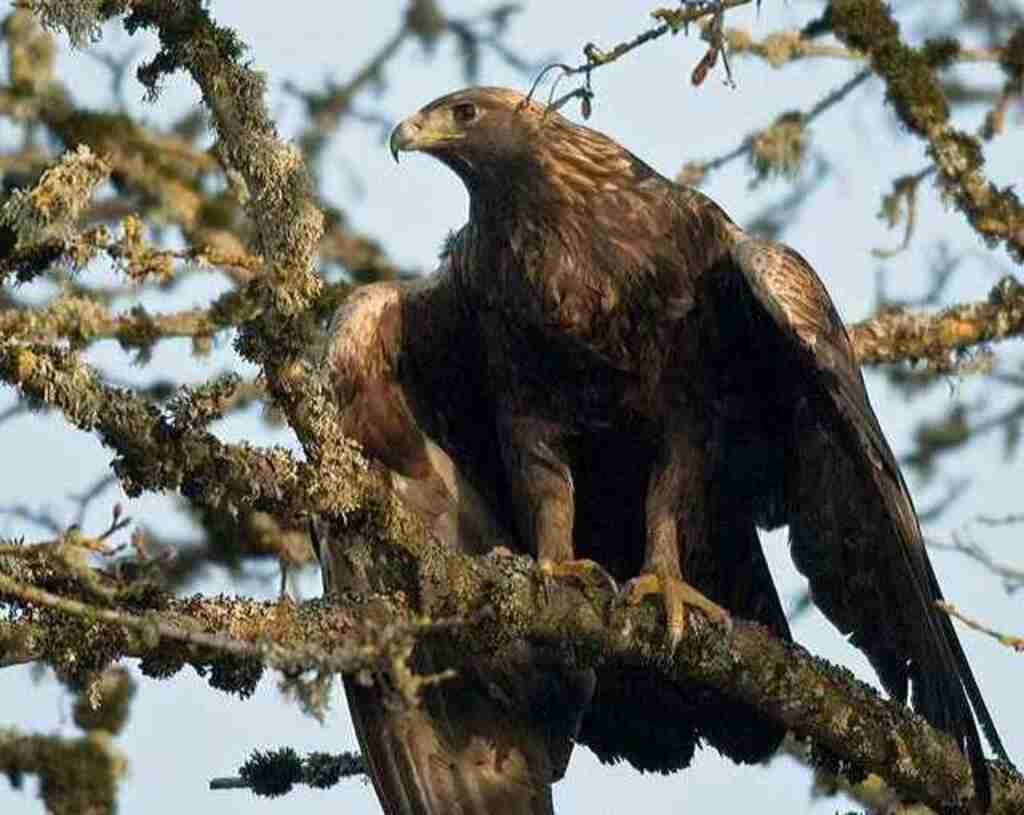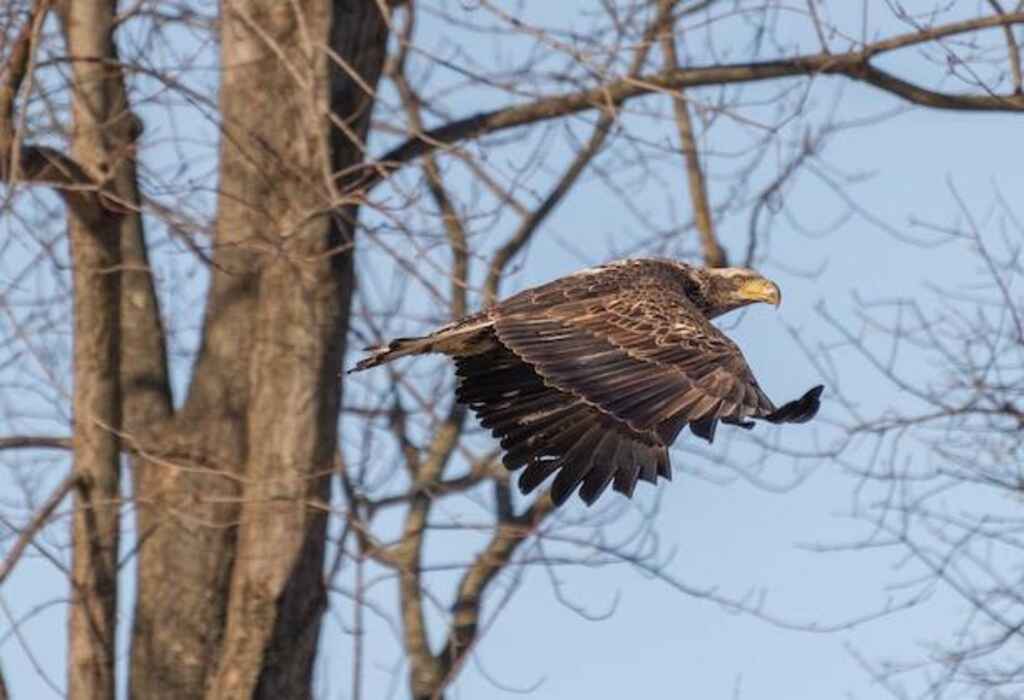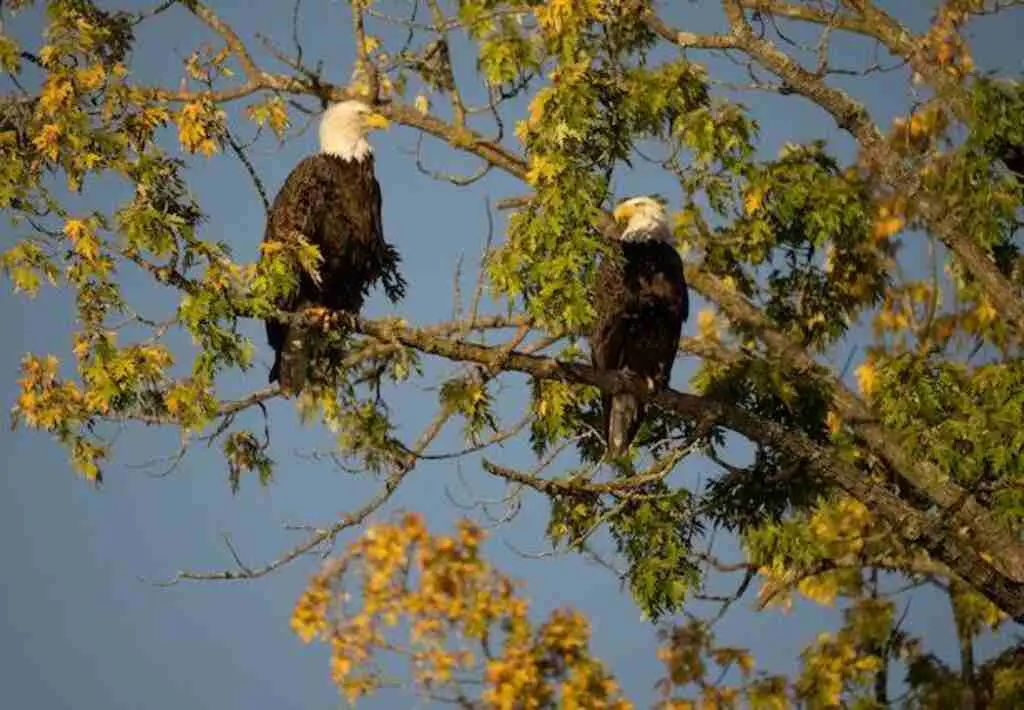In the vast expanse of the natural world, where the skies meet the earth, a delicate dance unfolds between two majestic creatures. High above, the eagle soars with grace, its keen eyes scanning the landscape below.
In stark contrast, the sloth moves languidly through the dense foliage, its slow and deliberate movements a testament to its arboreal existence.
These two beings, seemingly worlds apart, are connected by the intricate web of nature’s food chain.
The question lingers in the minds of curious observers: Do eagles, with their powerful beaks and talons, partake in the consumption of these gentle sloths?
In this article, we delve into the diet of eagles, the behavior and characteristics of sloths, their shared habitats, and the rare instances of eagle-sloth interactions.
By examining the scientific evidence and exploring the intricacies of these two creatures’ lives, we seek to shed light on the captivating question: Do eagles eat sloths?
Table of Contents
- 1 Key Takeaways
- 2 Do Eagles Eat Sloths
- 3 The Diet of Eagles
- 4 Sloth Behavior and Characteristics
- 5 Eagle and Sloth Habitat
- 6 Eagle Predation Patterns
- 7 Sloths as Prey for Eagles
- 8 Eagle and Sloth Coexistence
- 9 Sloth Defense Mechanisms
- 10 Eagle Feeding Preferences
- 11 Sloth Vulnerability to Predators
- 12 Rare Instances of Eagle-Sloth Interactions
- 13 Conclusion: Do Eagles Eat Sloths?
- 14 Frequently Asked Questions
- 14.1 How do eagles catch sloths?
- 14.2 Are sloths the primary prey for eagles?
- 14.3 What are the main factors that determine whether an eagle will attack a sloth?
- 14.4 Do eagles have any specific hunting techniques when targeting sloths?
- 14.5 Are there any recorded cases of eagles successfully hunting and consuming sloths?
- 15 Author
Key Takeaways
- Eagles and sloths coexist in the same habitat but occupy different niches.
- Sloths have evolved specialized adaptations to avoid detection by predators.
- Eagles primarily target smaller prey but sloths can become vulnerable due to their slow movement and limited defenses.
- Instances of interactions between eagles and sloths are rare due to their distinct habitats and dietary preferences.
Do Eagles Eat Sloths
While eagles generally do not commonly eat sloths, there have been rare instances of eagles preying on sloths. Eagles primarily feed on fish, small mammals, birds, and carrion.
Sloths, being arboreal mammals that mainly consume leaves, are not a typical part of the eagle’s diet. However, occasional opportunistic predation or scavenging behavior cannot be completely ruled out.
The Diet of Eagles
The dietary habits of eagles encompass a diverse range of prey, including but not limited to small mammals, birds, fish, and reptiles.
Eagles are known for their exceptional hunting techniques, which enable them to capture a wide variety of prey.
When it comes to hunting sloths specifically, eagles typically rely on their keen eyesight and powerful talons.
Sloths, on the other hand, are known for their slow and deliberate feeding habits, primarily consisting of leaves and fruits.
Despite eagles being capable of preying on small mammals, there is limited evidence of eagles actively hunting sloths.
This could be attributed to the sloth’s arboreal behavior and characteristics, such as their slow movements and well-camouflaged fur.
Transitioning into the subsequent section about sloth behavior and characteristics, it is important to explore their unique adaptations and survival strategies.
Sloth Behavior and Characteristics
The slow and deliberate nature of sloths is a characteristic that sets them apart from other animals. Sloths move at a very slow pace, spending most of their time hanging upside down from trees.
This slow movement is a result of their low metabolic rate, which allows them to conserve energy and survive on a diet of leaves.
In addition to their slow movement, sloths have developed various ways to protect themselves from predators.
One of the most notable defense mechanisms is their ability to camouflage with their surroundings.
The fur of sloths is covered in algae, which helps them blend in with the trees and makes them difficult to spot.
Furthermore, sloths have long, curved claws that they use to grip onto branches, making it challenging for predators to dislodge them.
Overall, the slow and deliberate nature of sloths, combined with their ability to camouflage and their strong grip, allows them to survive in their natural habitat and avoid potential threats.
The Slow and Deliberate Nature of Sloths
Characterized by their leisurely pace and deliberate movements, sloths possess a unique ability to captivate spectators with their unhurried demeanor, akin to a gentle dance performed in slow motion.
Sloths are known for their remarkably slow movement patterns, which allow them to conserve energy in their arboreal habitat.
Their slow and deliberate movements are a result of their specialized physiology and low metabolic rate.
Sloths have adapted to their environment by developing long and powerful limbs, which enable them to hang upside down from tree branches for extended periods without expending much energy.
Their slow pace also serves as a defensive mechanism against predators, such as eagles, as it makes them less noticeable and harder to catch.
Now, let’s explore how sloths protect themselves from their aerial adversaries.
How Sloths Protect Themselves
Sloths employ a variety of strategies to ensure their survival in the face of aerial predators. These slow-moving creatures have developed several mechanisms to protect themselves from eagle attacks.
- Sloth camouflage: Sloths have a unique fur coloration that helps them blend in with their surroundings, making it difficult for eagles to spot them among the tree branches.
- Cryptic behavior: Sloths minimize their movements and remain motionless for long periods, making it challenging for eagles to detect them.
- Arboreal lifestyle: Sloths spend most of their time in trees, where they are well adapted for climbing and maneuvering. This makes it harder for eagles to reach them.
- Hanging upside down: Sloths hang from tree branches upside down, which makes it even more challenging for eagles to approach them.
- Defensive adaptations: Sloths have sharp claws that they can use to defend themselves if an eagle gets too close.
These unique strategies contribute to the sloth’s ability to evade eagle-hunting techniques.
Transitioning into the subsequent section about ‘eagle and sloth habitat’, it is important to understand how these two species coexist in their shared environment.
Eagle and Sloth Habitat
Located high in the canopies of rainforests, where dense vegetation and towering trees dominate the landscape, sloths find themselves in a habitat that is well-suited for their slow-paced lifestyle.
The eagle and sloth cohabitation is influenced by the destruction of their habitat.
As the rainforests are cleared for human activities such as agriculture and logging, both species are forced to adapt to the changing environment.
This habitat destruction has a significant impact on eagle and sloth populations, as their survival and reproductive success are closely tied to the availability of suitable habitat.
The loss of trees and vegetation reduces the sloths’ ability to move freely and find food, while also limiting the eagles’ hunting grounds.
As a result, both species face increased challenges in finding resources and establishing territories.
This habitat degradation ultimately affects the balance between eagles and sloths, leading to changes in their predation patterns.
Eagle Predation Patterns
Rainforests, being home to a diverse range of species, witness a fascinating interplay between predators and prey, with eagles displaying distinct predation patterns.
Sloths, known for their slow-moving nature and arboreal lifestyle, are one of the prey species targeted by eagles.
Eagles employ various hunting strategies to capture sloths, taking advantage of their ability to fly and their acute vision.
They often perch on high branches or use thermal updrafts to survey the surrounding area for potential prey.
Once a sloth is located, eagles swoop down with remarkable speed and precision, using their sharp talons to seize the sloth. This predation pattern showcases the aerial superiority and hunting prowess of eagles.
Transitioning into the subsequent section about ‘sloths as prey for eagles,’ it is crucial to explore the adaptations of sloths that allow them to survive in the face of such predation pressure.
Sloths as Prey for Eagles
One of the remarkable features of sloths that allows them to survive in the face of predation pressure from aerial predators is their unique anatomy and physiology.
Sloths, with their slow and deliberate movements, are not easy prey for eagles.
However, eagles have developed various hunting strategies to catch sloths. They often target sloths when they are on the ground, as sloths are vulnerable and less agile in this position.
Eagles use their sharp talons to grasp the sloth and carry it away to a safe location where they can feed undisturbed.
Additionally, eagles may also attack sloths while they are hanging from trees, swooping down, and using their powerful beaks to deliver a lethal blow.
The coexistence between eagles and sloths is a complex dynamic that involves both predation and adaptation.
Eagle and Sloth Coexistence
The coexistence between eagles and sloths is an interesting topic to explore, as these two species share the same habitat.
Their relationship is influenced by various factors that impact their interactions. One such factor is the scarcity of food resources, which can lead to competition between the two species.
Additionally, the eagles’ predatory nature and the sloths’ slow movements also play a role in shaping their relationship.
Inhabiting the same ecosystem, eagles and sloths coexist harmoniously due to their distinct ecological niches.
While both species share the same habitat, they have evolved to occupy different niches within it, minimizing direct interaction.
Eagles, being predatory birds, primarily inhabit the upper canopy layer of the forest, where they hunt for small mammals, birds, and reptiles.
On the other hand, sloths spend most of their time in the middle and lower canopy layers, feeding on leaves and occasionally descending to the forest floor to defecate.
This spatial separation and differences in diet reduce competition between the two species. Additionally, sloths’ slow movements and cryptic coloration help them avoid eagle predation.
However, other factors that impact their relationship, such as deforestation and human activities, will be discussed in the subsequent section.
Other Factors that Impact Their Relationship
Another factor that influences the dynamic between eagles and sloths in their shared habitat is the ongoing deforestation and human activities, which have adverse effects on both species.
Sloth behavior and predator evasion are greatly impacted by the loss of their natural habitat.
Deforestation disrupts the sloth’s ability to move through the canopy, making them more vulnerable to predation by eagles.
Sloths rely on trees for both food and protection and as deforestation reduces the availability of suitable trees, their survival becomes increasingly threatened.
Additionally, human activities such as logging and land clearing can directly harm both eagles and sloths, either through direct injury or destruction of nesting sites.
Overall, the loss of habitat due to deforestation and human activities has a significant impact on the interactions between eagles and sloths.
This will be further explored in the subsequent section about ‘sloth defense mechanisms’.
Sloth Defense Mechanisms
Sloth defense mechanisms include their slow and deliberate movements, which allow them to blend in with their surroundings and avoid detection by predators such as eagles.
Sloths are well-known for their unique camouflage abilities, as their fur is covered in algae that helps them blend in with the trees they inhabit.
This camouflage, combined with their slow movements, makes it difficult for predators to spot them.
Additionally, sloths have survival tactics such as remaining motionless for extended periods of time, even when under threat. This behavior further enhances their ability to go unnoticed by potential predators.
These defense mechanisms have evolved over time to ensure the sloths’ survival in their natural habitat.
Transitioning into the subsequent section about ‘eagle feeding preferences,’ it is important to examine how sloth defense mechanisms affect the eagles’ ability to catch their prey.
Eagle Feeding Preferences
Predators such as eagles demonstrate distinct preferences in their feeding habits. When it comes to hunting sloths, eagles employ various techniques to secure their prey. These techniques include:
- Ambush: Eagles may perch on a high tree branch or hide in the canopy, waiting for an unsuspecting sloth to pass by.
- Aerial attacks: Eagles have been observed swooping down from the sky, using their sharp talons to snatch sloths off tree branches.
- Stealthy approach: Some eagles exhibit a patient and calculated approach, slowly inching closer to the sloth without alarming it until the final attack.
- Cooperative hunting: In some cases, eagles have been seen working together in pairs or groups to increase their chances of success.
These strategies highlight the adaptability and resourcefulness of eagles in their pursuit of prey.
Understanding eagle hunting techniques provides valuable insight into the challenges sloths face in their natural habitat, contributing to our understanding of sloth vulnerability to predators.
Sloth Vulnerability to Predators
Sloth behavior plays a crucial role in their ability to avoid predators.
Sloths are known for their slow movements and low activity levels, which make them less noticeable to potential predators.
Additionally, sloths have specialized adaptations such as their long claws and ability to hang upside down, which help them stay hidden and out of reach from predators.
However, despite these adaptations, sloths still face predation from a variety of other animals, including jaguars, harpy eagles, and snakes.
Sloth Behavior and Its Impact on Predator Avoidance
As masters of stillness and lethargy, sloths possess a remarkable ability to blend seamlessly with their forest surroundings, making it arduous for potential predators to spot them.
This sloth behavior plays a crucial role in predator-prey dynamics, as it increases their chances of survival in the face of constant threats.
By remaining motionless and hanging upside down in trees for extended periods, sloths minimize their chances of being detected by predators.
Their slow metabolism further aids in avoiding detection, as it reduces the need for frequent movements and decreases the chances of attracting attention.
However, despite their remarkable abilities, sloths are not completely immune to predation.
Other predators of sloths, such as jaguars and snakes, have developed strategies to exploit their vulnerabilities, which will be explored in the subsequent section.
Other Predators of Sloths
Sloths, with their slow and deliberate movements, have evolved several strategies to avoid predation. However, they are not only threatened by eagles but also by other predators in their natural habitats.
Jaguars, for instance, are known to be formidable hunters and have been observed preying on sloths. Additionally, ocelots and harpy eagles have also been identified as potential predators of sloths.
These predators employ various hunting techniques to capture sloths, including stealthy approaches, sudden attacks, and powerful strikes.
For example, harpy eagles, known for their immense size and strength, can swoop down from above and snatch sloths right off the trees.
This demonstrates the adaptability and resourcefulness of predators in their pursuit of sloth prey.
In the subsequent section, we will explore rare instances of eagle-sloth interactions, shedding light on the dynamics of these unique encounters.
Rare Instances of Eagle-Sloth Interactions
Rarely do instances of interactions between eagles and sloths occur in the wild due to their distinct habitats and dietary preferences.
Eagles are known for their excellent hunting techniques, which involve swooping down from great heights and using their sharp talons to capture prey.
On the other hand, sloths have adapted to survive in the treetops of tropical rainforests, where they primarily feed on leaves.
The vast majority of eagles prefer to target smaller animals such as rodents, birds, and fish, which provide a more suitable source of nutrition.
However, in rare cases where eagles and sloths do encounter each other, it is unlikely that the eagle would attempt to prey on the sloth due to their large size and the sloth’s ability to defend itself.
These infrequent interactions highlight the unique coexistence of different species in their respective ecosystems.
Transitioning into the next section, it is important to explore the question: do eagles eat sloths?
Conclusion: Do Eagles Eat Sloths?
In the realm of predator-prey dynamics, the interactions between eagles and sloths remain an intriguing and seldom-explored phenomenon. Despite the rarity of such encounters, there have been documented cases of eagles preying on sloths.
These interactions provide valuable insights into the sloth predation dynamics and the adaptability of eagles as opportunistic hunters.
While eagles are generally known to target smaller prey, sloths can become vulnerable due to their slow movement and limited defenses.
The unique arboreal lifestyle of sloths, spending most of their time in trees, presents an opportunity for aerial predators like eagles to exploit this niche.
Although the frequency of eagle-sloth interactions may be low, their existence highlights the complex and diverse nature of predator-prey relationships in the animal kingdom.
Further research is needed to comprehensively understand the factors influencing these interactions and their broader ecological implications.
Frequently Asked Questions
How do eagles catch sloths?
Eagles exhibit various hunting behaviors to catch sloths. They employ aerial attacks, specifically targeting vulnerable body parts. Sloths employ escape strategies by remaining motionless, blending with their surroundings, and relying on their strong grip to avoid predation.
Are sloths the primary prey for eagles?
Sloth ecology and eagle hunting behaviors are intriguing topics. Sloths play a significant role in the ecosystem due to their slow movements and abundance of vegetation. Eagles, while not exclusively preying on sloths, have been observed hunting them.
What are the main factors that determine whether an eagle will attack a sloth?
The main factors that determine whether an eagle will attack a sloth include the sloth’s habitat and the hunting strategies employed by the eagle. The sloth’s habitat provides opportunities for the eagle to locate and pursue its prey, while the eagle’s hunting strategies determine its ability to successfully capture and consume a sloth.
Do eagles have any specific hunting techniques when targeting sloths?
The eagle’s hunting behavior when targeting sloths involves the use of specific techniques. However, the sloth’s defense mechanisms may pose challenges to the eagle’s hunting success.
Are there any recorded cases of eagles successfully hunting and consuming sloths?
There have been documented cases of eagles successfully hunting and consuming sloths, indicating that sloth-eagle interactions exist. Further research is needed to understand the specific hunting techniques employed by eagles when targeting sloths.







